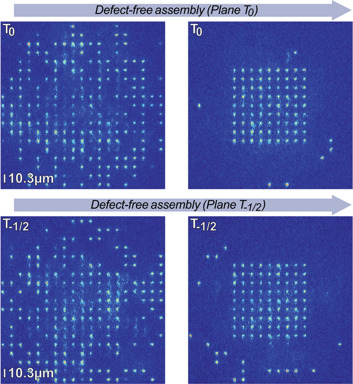 [Enlarge image]Quantum registers consisting of 81 atomic quantum bits per plane assembled in defect-free target structures in the focal plane (top) and in a Talbot plane (bottom). The in situ atomic fluorescence of individual atoms reveals the initial atom distribution (left) and the successful creation of a 9×9 cluster via atom-by-atom transport (right).
[Enlarge image]Quantum registers consisting of 81 atomic quantum bits per plane assembled in defect-free target structures in the focal plane (top) and in a Talbot plane (bottom). The in situ atomic fluorescence of individual atoms reveals the initial atom distribution (left) and the successful creation of a 9×9 cluster via atom-by-atom transport (right).
Quantum computers can in principle solve certain tasks much quicker even than supercomputers. However, the prototypes made thus far have had a maximum of a few hundred quantum bits (qubits). Quantum computers with many thousands of qubits, if not several millions, would be required for practical applications such as materials design, drug development or optimizing complex financial transactions or traffic flows. Adding qubits consumes resources, however, which has hampered the development of practical quantum computers.
In work published this year, we showed how the combination of advanced micro-optics, optical trapping and cooling of atoms, and the optical Talbot effect can be used to increase the number of qubits from several hundred to over ten thousand without proportionally requiring additional resources.1 In this implementation, qubits are represented by individual atoms, laser-cooled to a temperature of almost absolute zero. To control them in a targeted manner, the single-atom qubits are held in a regular lattice of focused laser beams. This optical-trapping architecture is produced in an innovative way: We shine a laser beam onto a glass element the size of a fingernail, on which lithographically produced microlenses are arranged in a pattern similar to a chessboard. Each microlens bundles a small part of the laser beam, thereby creating a lattice of focal points, each of which can hold a single atom.
This configuration gives rise to the Talbot effect: The layer of focal points is repeated multiple times at equal intervals, leading to the creation of “self-images” of the lattice in parallel planes above and below the focal plane. The high manufacturing precision of the microlenses leads to very regularly arranged self-images that can be used to hold additional qubits in additional layers. Therefore, a focal lattice in 2D becomes one in 3D with many times the qubit sites. The Talbot effect adds the additional layers for free, with no additional laser output required.
We were able to load these additional layers with individual atoms and to rearrange them to achieve defect-free qubit registers in different planes. With the given laser output, 16 such layers were created, potentially allowing for more than 10,000 qubits. We believe that 100,000 qubits and beyond will be possible in the foreseeable future.
In our view, the scalability in the number of qubits shown in this work represents an important step toward developing practicable quantum computers. We also foresee a variety of further applications in the field of quantum technologies, such as high-precision optical atomic clocks or quantum sensors for electric and magnetic fields.
Researchers
Malte Schlosser, Dominik Schäffner and Gerhard Birkl, Technical University of Darmstadt, Darmstadt, Germany
References
1. M. Schlosser et al. Phys. Rev. Lett. 130, 180601 (2023).
